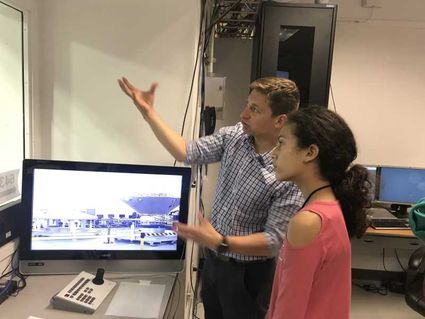12-Year-Old's "Experience of a Lifetime"
April 26, 2018
By Keira Mohammed, age 12
CCMS Student
Kid Scoop Media Scooper
As someone who has always been curious about outer space, it was the experience of a lifetime to get to see the newest Mars expedition, the InSight Lander! InSight stands for "Interior Exploration using Seismic Investigations, Geodesy and Heat Transport". The InSight Lander is a robot that is being sent to Mars inside an interplanetary spacecraft. The mission of this lander is to study the interior of Mars, and not the planet's surface, which was explored with previous rovers. It will take one Mars year, which is equal to two Earth years, to complete its mission.
To protect against contamination caused by bacteria and spores, they keep the Lander in a Clean Room at Vandenberg Air Force Base. Ryan Hendrickson, Planetary Protection Lead for InSight, stated "We want to protect other worlds from the microorganisms on Earth." I found it interesting that he specifically used the phrase 'other worlds' instead of 'planets' because it makes it feel like the universe is a lot bigger than we could ever imagine. Since humans naturally carry bacteria, we dressed in special environmental clean room suits, masks, gloves, booties, boots and hairnets. Next, we went into an air shower where we were advised to dance for a few seconds, turning fully around. The Lander would not be sent to Mars if it were contaminated by too many bacterial spores.
The interplanetary spacecraft that transports the Lander to Mars is called the cruise stage. This vehicle has a heat shield, which fits on top of the Lander. Betsy Pugel, Deputy to the Planetary Protection Officer at NASA Headquarters, explained that it protects the Lander by absorbing all the heat generated from entering the Martian atmosphere. "The heat shield works as an insulator, burning away in a process known as ablation, as the spacecraft enters the Mars atmosphere. It's a bit like when you burn toast – the outer part of the bread may be charred black, but the interior will remain white, because the material is an effective insulator."
The Lander is equipped with a heat probe and a seismometer. "[HP3] has got a heat probe that burrows itself down about 5 meters and has a trail of temperature sensors behind it that helps us understand if the core is still putting out any heat and how much." Scott Daniels, Assembly Test and Launch Operations Manager, told us. "[The SEIS is] an ultra precise, ultra sensitive seismometer that can measure motions less than the radius of a hydrogen atom."
The Lander also has instruments that measure the weather on Mars, a robotic arm used to put the instruments on the surface of Mars, and a camera to take photos. It takes months to deploy each of these instruments once the Lander arrives on Mars and it is all controlled from the Jet Propulsion Laboratories, JPL, here on Earth in Pasadena, California.
After viewing InSight, I realized something extremely astounding. I was the first person under 18 to ever be that close to a lander going to another planet! That seems pretty cool! I learned a lot and thought about one of the questions I had asked the scientists for fun. Even though they couldn't give me a straight answer, they replied that there is no way to disprove it and that there really could be life on Mars!



















Reader Comments(0)